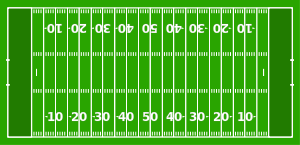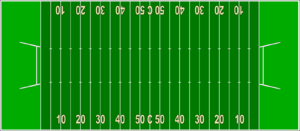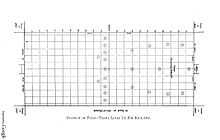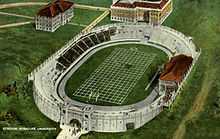Gridiron football


Gridiron football, or North American football,[1] is a form of football primarily played in the United States and Canada.[2][3][4][5][6] The predominant forms of gridiron football are American football and Canadian football.
The term "gridiron" originated as a description of the sport's then-characteristic playing field, which, until the late 1910s–early 1920s, was marked with a series of parallel lines in a checkerboard (or grid) pattern, resembling a gridiron.[7] The grid system was abandoned in favor of the system of yard lines and hash marks used today, but the term "gridiron" has survived.
"Gridiron" football developed in the late 19th century out of the older games related to the games now known as rugby football and association football. It is distinguished from other football codes by its use of hard plastic helmets and shoulder pads, the forward pass, the system of downs, a line of scrimmage, more specialist positions and formations, free substitution, platooning of different players for offense and defense, measurements in yards, a distinctive brown leather ball in the shape of a prolate spheroid, and the ability to score points while not in possession of the ball by way of the safety. Walter Camp is credited with creating many of the rules that differentiate gridiron football from its older counterparts.
The international governing body for gridiron football is the International Federation of American Football (IFAF); although the organization uses the name "American football" and plays all of its international competitions under American rules, it uses a definition of the game that is broad enough that it includes Canadian football under its umbrella, and Football Canada (the governing body for Canadian football) is an IFAF member.
Terminology

The term "gridiron" in reference to football first developed in the United States as a description of the sport's then-characteristic playing field, which originally was marked with a series of parallel lines in a checkerboard (or grid) pattern, resembling a gridiron.[7]
The word "gridiron," in use since the 14th century, refers to a metal grid for cooking food over a fire, and derives from the same root as "griddle."[7]
As described in Outdoor Sports and Games (1911), by Claude H. Miller:—
A football field is 330 feet long by 160 feet wide. At each end are goal posts set 18 feet 6 inches apart, with a crossbar 10 feet above the ground. The field is marked off in chalk lines similar to a tennis court, these lines being 5 yards apart. The centre of the field where the play starts is 55 yards from either end. It is usually customary to run lines parallel to the sides of the field, also 5 yards apart, but as a field is but 160 feet wide the first and last of these lines are but 5 feet from the side lines instead of 5 yards. The lines on a football field make a checkerboard effect and have given to the field the name of "gridiron."

As a result, the name of the field, "gridiron," was applied to the game itself. The ball would be snapped in the grid in which it was downed on the previous play. The grid system was abandoned in favor of the system of yard lines and hash marks used today, but the term "gridiron" has survived.
Especially outside of the U.S. and Canada, the terms "gridiron" and "gridiron football" are often used to distinguish the North American sport from other codes of football. "Gridiron" is particularly common in Australia and New Zealand.[5][6][8] In some cases the terms are used specifically for American football, sometimes even in distinction from Canadian football,[9] though it is now often used as a blanket term for all North American variants.[3]
In the United States and Canada, the game is known unambiguously as football; the term gridiron is often used in a more poetic sense or for more colorful newspaper headlines. Association football is known in these countries as "soccer."
Gridiron football codes
- American football is the most common and widely known of the gridiron-based football codes. It is played with eleven men to a side, four downs and a 100-yard field. The IFAF uses the name "American football" in its name and statutes, identifying it as being "made up by American football played under whatever set of rules, Canadian football, flag football, touch football, peewee-football, indoor American football and related activities for amateur and professionals". Note that the premier professional league in the United States, the NFL, has its own distinct code, Official Playing Rules of the National Football League. Colleges in the United States generally play under the code defined in NCAA Football Rules and Interpretations. High Schools in America generally follow the rules and interpretations published by the National Federation of High School Associations (NFHS), although some states follow the NCAA code for high school play. Youth games (below high school age) generally follow NFHS code with modifications. Adult semi-pro, alternative or minor professional, amateur, touch, flag, etc. may follow any one of these codes or use their own rules. While the vast majority of the game is the same among these three codes, subtle variations in rules can lead to large difference in play. Many of the differences are in penalty enforcement and the definitions of fouls.
- Canadian football is played almost exclusively in Canada. It was originally more closely related to rugby until the Burnside rules were adopted. The game is played on a 110-yard field and has three downs and twelve men to a side. The Canadian game also allows players to move forward toward the line of scrimmage before the snap, which is forbidden in most versions of American football, and also features a one-point "single" (formally called a "rouge") for a ball kicked into the end zone and not returned by the receiving team. Like the American game, the Canadian Football League and Canadian Interuniversity Sport both have their own rulebooks for the game, although there are generally fewer differences than between their American counterparts.
- Nine-man football, eight-man football and six-man football are varieties of gridiron football played with fewer players. They are played with four downs (often with a 15 yard requirement for a new set of downs, as opposed to 10 in other codes), fewer offensive linemen, and an 80-yard field. These games are generally based on the high school rulebooks, which have an addendum devoted to the play of these codes.
- Indoor football is played with special rules to accommodate smaller indoor facilities. It is played on a 50-yard field with seven or eight men to a side (depending on the league). Prototype games were played in 1902 and 1932, both of which used the shortened field but followed the outdoor standard 11 men to a side. However, indoor football did not gain popularity until James F. Foster's proprietary version, arena football, debuted in 1986, and set most of the standards for indoor leagues today. As almost all indoor leagues are for-profit professional leagues, each league has its own proprietary code.
- Touch football, flag football and backyard football are informal varieties of the game, played primarily at an amateur and recreational level. No specific rulebooks are universally recognized for these variants, where house rules usually apply.
Leagues
| League | Sport | Year Founded | Teams | Revenue US$ (bn) | Average Attendance | Average Salary |
|---|---|---|---|---|---|---|
| National Football League | American football | 1920 | 32 | $9.0 | 67,604 | $1,900,000 |
| Canadian Football League | Canadian football | 1958 | 9 | $0.1 | 27,005 | $80,000 |
| Arena Football League | Indoor football | 1987 | 12 | 8,473 | $15,000 | |
Play of the game

This is a minimal description of the game in general, with elements common to all or almost all variants of the game. For more specific rules, see each code's individual articles.
Prior to the start of a game, a coin toss determines which team will kick off the ball to their opponent. Each team lines up on opposite halves of the field, with a minimum ten yards of space between them for the kickoff.
At this point, play from scrimmage begins. The team in possession of the ball is on offense and the opponent is on defense. The offense is given a set amount of time (up to forty seconds, depending on the governing body, during which the teams can set up a play in a huddle and freely substitute players) to set into a formation, in which the offense must remain perfectly still for at least one second (the formation requirement does not apply to Canadian football). At least half of the players (seven in standard American and Canadian football) on the offense must line up on the line of scrimmage, including the snapper, who handles the ball before play commences; the rest can (and almost always do) line up behind the line. Neither the offense nor the defense can cross the line of scrimmage before the play commences. Once the formation is set, the snapper snaps the ball to one of the players behind him. The play has now commenced, and the offense's goal is to continue advancing the ball toward their opponent's end zone. This can be done either by running with the ball or by a rule unique to gridiron football known as the forward pass. In a forward pass, a player from behind the line of scrimmage throws the ball to an eligible receiver (another back or one player on each end of the line), who must catch the ball before it touches the ground. The play stops when a player with the ball is tackled to the ground, runs out of the boundaries of the field, or a forward pass hits the ground without being caught (in the last case, the ball returns to the spot it was snapped). At any time, the player with the ball can attempt a backward, or lateral, pass to any other player in order to keep the ball in play; this is generally rare. A typical play can last between five and twenty seconds, and as a result, the majority of the time in a gridiron football game is eaten up between the plays, when there is little to no on-field action.
In order to keep play moving, the offense must make a certain amount of progress (10 yards in most leagues) within a certain number of plays (3 in Canada, 4 in the United States), called downs. If the offense does indeed make this progress, a first down is achieved, and the team gets 3 or 4 more plays to achieve another 10 yards. If not, the offense loses possession to their opponent at the spot where the ball is. More commonly, however, the team on offense will, if they have a minimal chance of gaining a first down and have only one play left to do it (fourth down in the U.S., third down in Canada), attempt a scrimmage kick. There are two types of scrimmage kick: a punt is when the ball is kicked downfield as far as possible; the kicking team loses possession of the ball after the kick and the receiving team can attempt to advance the ball. The other scrimmage kick is a field goal attempt. This must be attempted by place kick or (more rarely) drop kick, and if they pass through the goal set at the edge of the opponent's end zone, the team scores three points (four in rare variants and special circumstances).
If the team in possession of the ball, at any time, advances (either by carrying or catching) the ball into the opponent's end zone, it is a touchdown, and the team scores six points and a free play known as a try. In a try, a team attempts to score one or two points (rules vary by each league, but a field goal on a try is usually worth one point while another touchdown is worth two).
If the player with the ball is tackled while he is in his own end zone, or if a team throws or fumbles the ball out of its own end zone, the defense scores a safety, worth two points.
After a try, safety or field goal, the team that had possession of the ball goes back to the middle of the field and kicks the ball off to their opponent, and play continues as it did in the beginning of the game.
Play continues until halftime. (Each team switches their side of the field with the other halfway through each half, at the end of a quarter.) After the halftime break, a new kickoff occurs. Whichever team has more points at the end of the game is declared the winner; in the event of a tie, each league has its own rules for overtime to break the tie. Because of the nature of the game, pure sudden-death overtimes have been abolished at all levels of the game as of 2012.
Usage
The word gridiron alone can refer either to the field or to the sport. In North America, however, it is mostly used in reference to the field, usually in a somewhat figurative or poetic sense (e.g. "the players are getting set to battle it out on the gridiron"). In some other English-speaking countries—particularly Australia and New Zealand—it is the primary term used to refer to the sport, differentiating it from other forms of football such as Australian rules football, association football, rugby league, and rugby union.[5][6] In British parlance the most frequently used term is American football, but gridiron is also used to describe the game.[4][10] In the United States and Canada, the sport is known unambiguously as football.
See also
- Football (word)
- Comparison of Canadian and American football
- Glossary of American football
- Glossary of Canadian football
References
- ↑ See, for example: Jack Brimberg and William Hurley (2006). "Strategic considerations in the coaching of North American football". International Journal of Sport Management and Marketing. From International Journal of Sport Management and Marketing, Volume 1, Number 3, pp. 279–287.
- ↑ "Gridiron football". Encyclopaedia Britannica. Retrieved October 20, 2010.
- ↑ 3.0 3.1 Carlisle, pp. 237–239.
- ↑ 4.0 4.1 Kelso, Paul (2007-10-27). Gridiron: on its way to Wembley. (London) The Guardian, October 27, 2007. Retrieved from http://www.guardian.co.uk/uk/2007/oct/27/uknews4.mainsection1.
- ↑ 5.0 5.1 5.2 Louis S. Leland (1984) http://books.google.com/books?id=FqlEe5d4yJ8C&pg=PA39&dq=gridiron+new+zealand&hl=en&ei=SbYPTPO1McalOLessPwK&sa=X&oi=book_result&ct=result&resnum=7&ved=0CEwQ6AEwBg#v=onepage&q=gridiron%20new%20zealand&f=false personal Kiwi-Yankee dictionary] Pelican Publishing Company, 1984
- ↑ 6.0 6.1 6.2 O'Brien, Kerry (1999-08-04). Gridiron comes to Australia. Retrieved from http://www.abc.net.au/7.30/stories/s41614.htm.
- ↑ 7.0 7.1 7.2 "Gridiron, n. (3.e.)". Oxford English Dictionary. 1989. Retrieved October 20, 2010.
- ↑ Funge, p. 41.
- ↑ See, for example, Encyclopaedia Britannica (2009). Britannica Almanac 2009. Encyclopaedia Britannica, Inc. p. 868. Retrieved October 20, 2010.
- ↑ Simon Hart, Chambers pursues old path to gridiron glory, The Daily Telegraph, Mar 20, 2004
Bibliography
- "Gridiron football". Encyclopaedia Britannica. Retrieved October 20, 2010.
- "Gridiron comes to Australia". From 7:30 Report. Retrieved on 2007-10-09 from http://www.abc.net.au/7.30/stories/s41614.htm.
- Encyclopaedia Britannica (2009). Britannica Almanac 2009. Encyclopaedia Britannica, Inc. Retrieved October 20, 2010.
- Carlisle, Rodney P. (2009). Encyclopedia of Play in Today's Society, Volume 1. SAGE. ISBN 1-4129-6670-1.
- Funge, Noel (2000). An Australian Dictionary for North Americans. General Store Publishing House. ISBN 1-894263-22-7. Retrieved October 20, 2010.
| ||||||||||||||||||||||||||||||||||||||||||||||||||||||||||||||
| ||||||||||||||||||||||||||||||||||||||||||||||||||||||||||||||||||||||||||||||||||||||